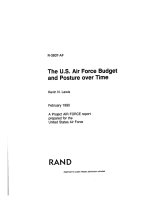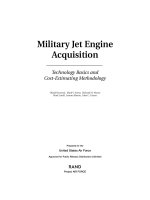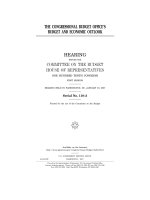7 ct8 art qap bcc budget and cost control
Bạn đang xem bản rút gọn của tài liệu. Xem và tải ngay bản đầy đủ của tài liệu tại đây (399.77 KB, 8 trang )
PROJECT OF HIGHRISE BUILDING – SERVICES IN LANDZONE CT8
PROJECT MANAGEMENT
QUALITY ASSURANCE PLAN -BUDGET AND COST CONTROL
ARTELIA VIETNAM
Fl.11, HQ Building 193 C3 Bà Triệu. Ha Noi
Tel.: +84 (04) 3734 7260
DATE:
NOV. 2017
REF:
CT8.ART.QAP.BCC
PROJECT OF HIGHRISE BUILDING – SERVICES IN LANDZONE CT8
project management
QUALITY ASSURANCE PLAN -BUDGET AND COST CONTROL
REVISION
COMMENTS
DATE
00
DRAFT for comment
01/11/2017
st
1 submission
01
02
03
LƯU CHUYỂN TỚI
Client – MY
DINH REAL ESTATE INVESTMENT JOINT STOCK COMPANY
PM - ARTELIA
Consultants/ Contractors
/ CT8.ART.QAP.BCC / NOV. 2017
A
PROJECT OF HIGHRISE BUILDING – SERVICES IN LANDZONE CT8
project management
QUALITY ASSURANCE PLAN -BUDGET AND COST CONTROL
CONTENTS
1.
PROJECT COST ESTIMATE ______________________________________ 1
1.1. METHOD FOR COST ESTIMATION ____________________________________________ 1
1.2. CALCULATING A COST ESTIMATION ________________________________________ 1
1.3. HANDOVER A COST ESTIMATE TO THE CLIENT _____________________________ 2
2.
BUDGET CONTROL ______________________________________________ 3
2.1. INTRODUCTION _______________________________________________________________ 3
2.2. ESTABLISHING A BUDGET ___________________________________________________ 3
2.3. FOLLOW-UP OF EXPECTED AND COMMITED EXPENSE______________________ 3
2.3.1.
2.3.2.
2.3.3.
2.3.4.
2.3.5.
2.3.6.
BUDGET FOLLOW-UP ______________________________________________________________
CONTRACT AMOUNT AND VARIATION ______________________________________________
BREAKDOWN OF VARIATION _______________________________________________________
IDENTIFICATION, CALCULATION AND CONTROL OF VARIATION ______________________
VARIATION ORDER ________________________________________________________________
RECONCILIATION OF BUDGET CONTROL ____________________________________________
/ CT8.ART.QAP.BCC / NOV. 2017
3
4
4
4
5
5
B
PROJECT OF HIGHRISE BUILDING – SERVICES IN LANDZONE CT8
project management
QUALITY ASSURANCE PLAN -BUDGET AND COST CONTROL
1.
PROJECT COST ESTIMATE
1.1.
METHOD FOR COST ESTIMATION
A project cost can be estimated according to 2 different methods:.
Ratios: they are prices that are related to an area unit (in m²) – these rates are obtained from data
acquired duri ng previous projects – they are to be considered as minima, since they are the result
of a tender process. Ratios are also to be used carefully, since each project has its own
characteristics. Also consider the date of value and update them accordingly if needed.
The estimate result of the multiplication of ratios by floor areas that are to be consistent with the
method, by which the ratios were calculated.
Composite price: The use of ratios alone is inappropriate for certain trades or works and not
enough accurate during the most advanced design phase (detailed design). It is then necessary to
calculate quantities and to multiply them by composite price calculated as the combination of
different rates.
The use of ratios or composite price depends on the progress of the design. The project shall be
broken down into logical elements so that they can be easily retrieved.
They exclude construction management fees.
1.2.
CALCULATING A COST ESTIMATION
The utilization of ratios or composite price is not the same according to the project’s design phases:
During the preliminary design phase, global ratios should be used to estimate trades or group
of trades, and composite price for approximate quantities
Whatever the project phase considered, the cost estimate shall also include:
Contingencies: this provisional sum is a percentage of the estimated work amount that can vary
between:
3 to 5% for new building projects
6 to 10% for works on existing building (refurbishment,…)
It takes into account unexpected events that can occur during the duration of the execution phase
due to the fact that:
The design studies have been more or less well defined (depending of the time allotted for
them), leading to inconsistencies or omission in the scope of Works.
Variations are introduced or not during the later stages
Existing building or environment may create unexpected difficulties.
Construction time is too short
/ CT8.ART.QAP.BCC / NOV. 2017
1
PROJECT OF HIGHRISE BUILDING – SERVICES IN LANDZONE CT8
project management
QUALITY ASSURANCE PLAN -BUDGET AND COST CONTROL
Contractors may fail (delays, bankruptcy,…) during the construction
Approximation factor: it takes into account the lack of definition of certain aspects of the project,
the inaccuracy of the design, the evolution of the conjuncture etc…. This is a percentage of the
estimated work amount that decreases with the project’s course. The usual factors are the
following:
Feasibility phase: 15 to 10%.
Preliminary design phase: 10 to 8%
Detailed design phase (beginning): 8 to 5%.
Detailed design phase (end): 5 to 3%.
Owner’s attention shall be drawn on that point: a cost estimate cannot be the exact project value,
because it is based on previous projects built during a certain conjuncture that can never be the
same. Therefore, the approximation factor shall be given with the estimate.
Basic rules:
1.3.
Contingencies are added to the cost estimate.
Approximation factor is not added, because it can be a “plus” or a “minus”. The Owner may
decide or not take this factor into account
HANDOVER A COST ESTIMATE TO THE CLIENT
The presentation is very important. It shall be made clear that it is a cost estimate and not a
quotation.
The document handed over shall contain:
The general characteristics of the project (type of project, surfaces, reference document on
which the estimate is based…).
The given data for the cost estimate: date of value, approximation factor
The main economic indicators (Total amounts split by main areas and the principal ratios)
The description of the works or services not taken into account in the estimate.
The detailed calculation (in general)
Before handing over to the Client, the cost estimate shall be reviewed and validated by the
Director.
It is strongly advised to comment verbally the result of the estimate to the Client, to explain the
hypothesis taken into account.
/ CT8.ART.QAP.BCC / NOV. 2017
2
PROJECT OF HIGHRISE BUILDING – SERVICES IN LANDZONE CT8
project management
QUALITY ASSURANCE PLAN -BUDGET AND COST CONTROL
2.
BUDGET CONTROL
2.1.
INTRODUCTION
The budget control is one of the most important missions during a project. It shall be updated on a
continuous basis and is given monthly to the Client. It is one of the elements constituting the
reporting:
The general principle consists in comparing the evolution of committed or expected expenses with
the budget that can also be evolutionary.
2.2.
ESTABLISHING A BUDGET
The budget of a project is to be agreed with the Client: it is based on the initial project cost estimate
validated by the Client and the provisions for contingencies: this initial budget is called “Budget
Origin” and does not change
During the project’s course, the Client may request modifications of the original scope to what has
been initially budgeted: in this case, a new budget updated from time to time and called “Target
Budget” takes into account the provisional sums to be spent in accordance with these
modifications. This “target budget” may also be modified in case of transfer from another trade (in
this case, it does not change the overall budget).
In order to ensure a closer follow-up during the project’s progress, it is necessary to split the overall
budget into single budget for each trade. The overall provision for contingencies may be split
between the different trades either proportionally or according to another breakdown, according to
the type of trade (depending of the likeliness of having contingencies or not).
2.3.
FOLLOW-UP OF EXPECTED AND COMMITED EXPENSE
2.3.1. BUDGET FOLLOW-UP
For any project assignment, QS department will make cost estimate ready even before project
implementation whatever the workscope is. After the project contract is signed, all related parties
how clearly the budget of the whole project and the amount allocated for each parties and for
Artelia in particular. Based on the amount and the cost estimate prepared before hand, the PM or
the project team leader can make projection of the budget allocation for certain items as well as
certain phases during the whole process of project assignment. He or she can refer to the template
named ART.SEA/BLD.037 Budget control EN-VN. This form can be used to make the basic for
tracking and updated incase of change of addition budgeting during the project implementation
period.
The project itself includes many packages and many trades with various contractors and
subcontractors. It is also necessary for PM or PA to know the detailed budget allocation ofr each
package each trading. She or she can make the follow-up file under the format of excel sheet and a
recap sheet at the beginning. The excel file with specific breakdown for this item can be
customized based on particular project and its size. This foilow up is very important in case of
comparing to the total budget control mentioned above. Remember that these spreedsheet details
all expected and commited expenses for the package or trade to play as an explanation for the
overall budget when it come to a case of checking and reconciliation.
/ CT8.ART.QAP.BCC / NOV. 2017
3
PROJECT OF HIGHRISE BUILDING – SERVICES IN LANDZONE CT8
project management
QUALITY ASSURANCE PLAN -BUDGET AND COST CONTROL
2.3.2. CONTRACT AMOUNT AND VARIATION
For each trade, after the tender process and the contractual negotiation with the contractor, it is
possible to set up the contract amount (lump sum price) that will be the amount of reference for the
budget control. This amount is written down in the column “Contract” of the follow-up schedule; it
should be the one and only figure to appear in that column.
Variations correspond to unexpected works that have not been identified before the conclusion of
the contract. They need to be formally authorised by a separate notice to proceed or a variation
order signed by the Client
2.3.3. BREAKDOWN OF VARIATION
To allow an efficient budget control, these variations must be identified and followed-up separately
according to the following charge breakdown
Unexpected works for which contingencies have been allowed. For simplification purposes,
this charge type will subsequently be called “Contingencies”.
Variation of scope or quantities as per requested by the Client during the Construction. This
charge type will subsequently be called “Scope Modification” or “ScopMod”
The Other types of expenses (e.g. works ordered by the future users, or for the account of
other trades)
The chosen charge for one of these types of variation should be definitive.
2.3.4. IDENTIFICATION, CALCULATION AND CONTROL OF VARIATION
As soon as an additional work is expected (either formally requested or simply identified because
of the circumstances), a provisional amount shall be calculated (estimated) and a corresponding
line is added in the budget control schedule with the description and the amount in italic in the
related column (either as a contingency or as a scope modification). The expense type is at this
stage: “provision”.
After having checked the need of the variation, compared it with the original scope and verified that
additional works were not included in the contract, the Project Management shall get from the
contractor a quotation. The amount of the quotation received can be overwritten in the budget
control schedule on the provisional amount and the expense type becomes “initial quotation”.
Upon receipt of that quotation, the Project Management shall:
Make sure that the scope of variation is described unambiguously.
Check amended quantities
Verify the applicable rates (contractual, obtain by analogy or created) and the related
calculation.
Not forget omitted works that have to be deducted from the variation.
It is important to verify each quotation received, to amend it manually if necessary and to let the
contractor sign on the agreed amount on the very same document. This shows the Client that we
have reviewed and negotiated each variation.
If the quotation is reviewed and accepted by the PM, but not yet regularised by a variation order,
the corresponding expense type becomes “Quotation accepted”.
/ CT8.ART.QAP.BCC / NOV. 2017
4
PROJECT OF HIGHRISE BUILDING – SERVICES IN LANDZONE CT8
project management
QUALITY ASSURANCE PLAN -BUDGET AND COST CONTROL
If the amount is rejected or cancelled by the Client, it shall appear in the last column “Amount
refused”, to keep a record of what has been quoted by the contractor and of information about
possible future claims
2.3.5. VARIATION ORDER
Once the quotation for a variation has been agreed by the Project Management and the Client, a
Variation Order (or at least a Notice to Proceed) shall be issued to the Contractor. Its
corresponding reference (trade number and chrono number) and issue date are added in the
follow-up schedule and the amount shall appear in one of the relevant column (“Contingency”,
“ScopMod” or “other”) and is considered as a committed expense. (The corresponding expense
type becomes “Committed”)
The total of committed expenses for each trade (Contract + contingencies + ScopMod + other) is
compared with the target budget that is the sum of: Budget Origin + Total of ScopMod + possible
budget transfers.
2.3.6. RECONCILIATION OF BUDGET CONTROL
Using the Excel spreadsheet of the budget follow-up, it is possible to add as many sheets as
needed by copying the initial ones, to adjust their number in function of the number of the project
trades.
Each sheet is linked to the front page that is a recap of all trades (one line per trade) showing
budgets, committed expenses per charge type, and the percentage thereof
oOo
/ CT8.ART.QAP.BCC / NOV. 2017
5









